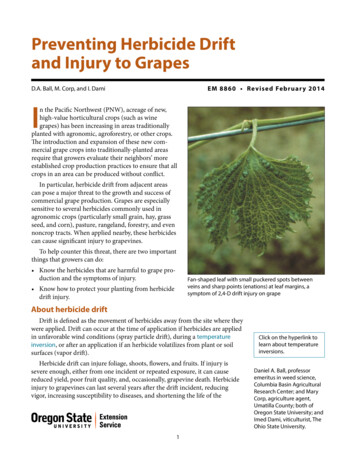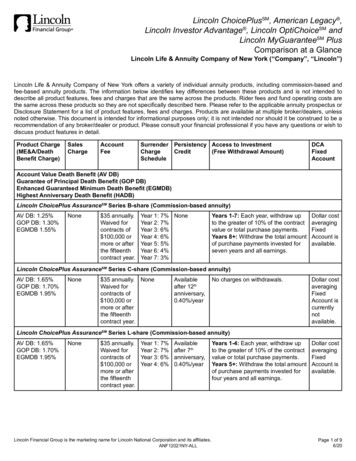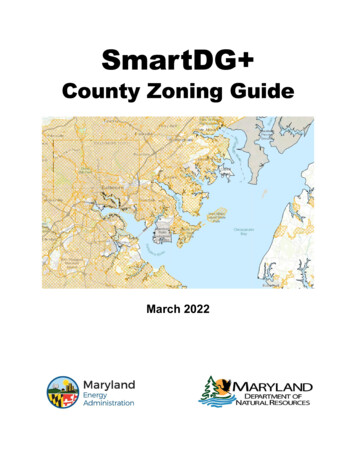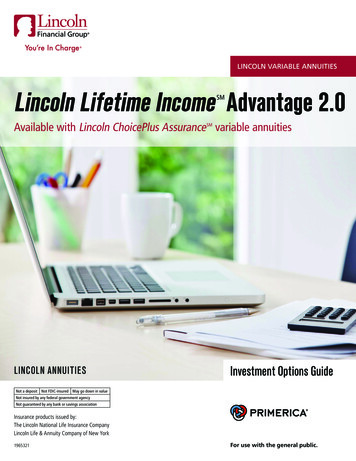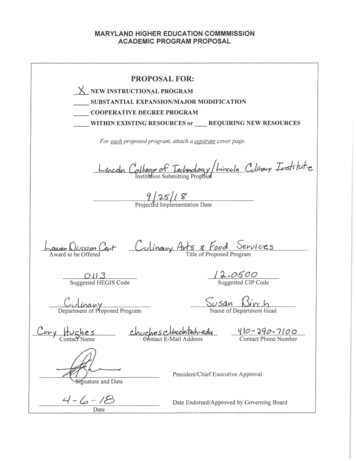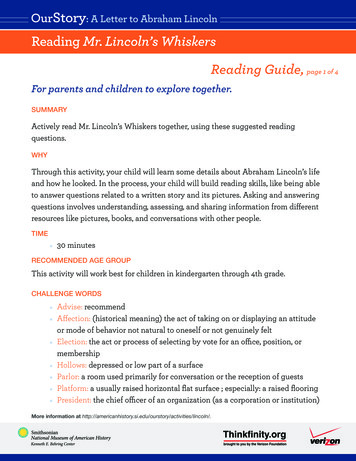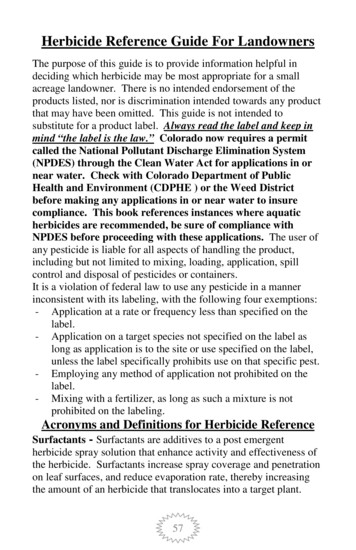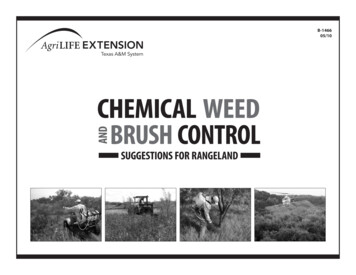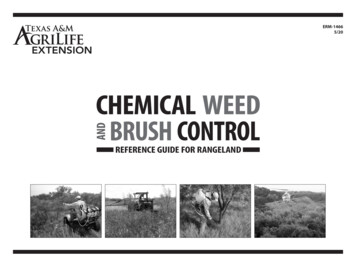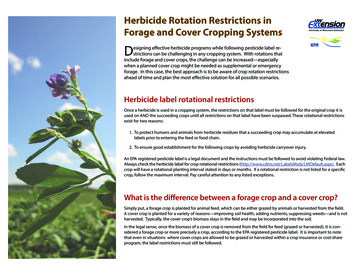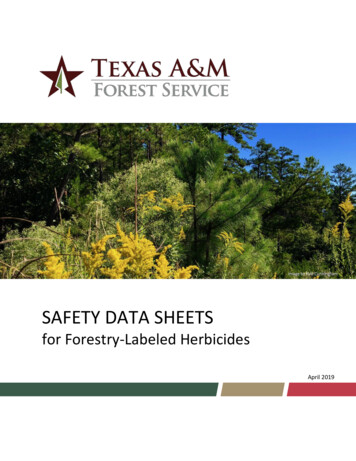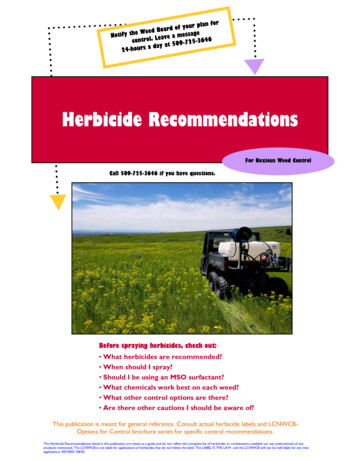
Transcription
Herbicide RecommendationsFor Noxious Weed ControlCall 509-725-3646 if you have questions.Before spraying herbicides, check out: What herbicides are recommended? When should I spray? Should I be using an MSO surfactant? What chemicals work best on each weed? What other control options are there? Are there other cautions I should be aware of?This publication is meant for general reference. Consult actual herbicide labels and LCNWCBOptions for Control brochure series for specific control recommendations.The Herbicide Recommendations listed in this publication are meant as a guide and do not reflect the complete list of herbicides or combinations available nor any endorsement of anyproducts mentioned. The LCNWCB is not liable for applications of herbicides that do not follow the label. The LABEL IS THE LAW and the LCNWCB will not be held liable for any missapplications. REVISED 4/8/20
Page 2Table of ContentsSome Services Provided by the Weed Board . . 3Getting a Pesticide Applicator’s License . .4What is a Restricted-Use Pesticide? . . . .4Herbicides,Their Chemical Names . .5Calibrations, Conversions and Measurements 7Herbicide Recommendations, A-C . .8Herbicide Recommendations, C-F. .9Herbicide Recommendations, H-L. . . .10Herbicide Recommendations, M-P. . .11Herbicide Recommendations, P-S. . .12Herbicide Recommendations, S-Y. .13What Should You Do After Spraying?.14Are Herbicides Poisonous?. . .14Where Do You Purchase Telar and Escort?. .15The Herbicide Recommendations listed in this publication are meant as a guide and do not reflect the complete list of herbicides or combinations available nor any endorsement of anyproducts mentioned. The LCNWCB is not liable for applications of herbicides that do not follow the label. The LABEL IS THE LAW and the LCNWCB will not be held liable for any missapplications. REVISED 4/8/20
Notify the Weed Board of your plan for control. Leave amessage24-hours a day at 509-725-3646Page 3Some Services Provided by the Weed Board Landowners are responsible for controlling noxious weeds on their property, perRCW 17.10. The Weed Board provides technical assistance, including numerous brochuresand pamphlets, to assist landowners in controlling their noxious weeds. Weed Board staff will meet with landowners on their property for “weedwalks” to identify plants and problem weeds, and to recommend options andsolutions. The Weed Board will provide landowners with GPS points on maps to indi-cate the location of noxious weeds on their property, if needed. At a landowner’s request, provide maps and assistance to commercialsprayers to facilitate weed control on a landowner’s property. This is especiallybeneficial to absentee landowners who own vacation property in the county. The Weed Board will loan out a 4-gallon backpack sprayer to landowners atno charge. We do require a 100 deposit (check only) that is fully refundablewhen the sprayer is returned in the same condition. The Weed Board conducts an annual pesticide re-certification each fall. The seminar offers re-certificationcredits for those already licensed. Licensed applicators may use a Weed Board computer toearn on-line pesticide license credits from WashingtonState University. Call ahead for an appointment.The Herbicide Recommendations listed in this publication are meant as a guide and do not reflect the complete list of herbicides or combinations available nor any endorsement of anyproducts mentioned. The LCNWCB is not liable for applications of herbicides that do not follow the label. The LABEL IS THE LAW and the LCNWCB will not be held liable for any missapplications. REVISED 4/8/20
Page 4Getting a Pesticide Applicator’s LicenseWhat are the advantages? A licensed applicator can purchase larger quantities of herbicides. A licensed applicator can purchase and use “Restricted-Use”Pesticides. Some of the active ingredients found in “Restricted-Use”Pesticides include Atrazine, Diuron, Picloram and Simazine. There are 450 Restricted-Use Pesticides in the state ofWashington. “Restricted-Use Pesticides” are herbicides judged by the EPAand the state of Washington Department of Agriculture to be hazardousto humans and non-targeted species. Due to the safety threat, licensed applicators must maintain precise recordkeeping on their use, including date, calibration, temperature, wind conditions, targeted weeds, and amount used. Hazards to humans are evaluated based on whether a pesticide exceeds established levels for acute or dermal toxicity, inhalation concentration, eye and skincorrosiveness, and whether the pesticide causes significant chronic or delayedtoxic effects. How to get a Pesticide Applicator’s LicenseContact the Dept. of Agriculture at 222 N. Havana Street,Spokane Valley (509-533-2690) for an application. Pay the fees, study the materials and pass the examination.*Any federal Restricted-Use Pesticide is automatically restricted in the state of Washington.Are there effective pesticides available if I don’t have an Applicator’sLicense? There are lots of herbicides available to landowners for effective control ofnoxious weeds. See our recommendations.The Herbicide Recommendations listed in this publication are meant as a guide and do not reflect the complete list of herbicides or combinations available nor any endorsement of anyproducts mentioned. The LCNWCB is not liable for applications of herbicides that do not follow the label. The LABEL IS THE LAW and the LCNWCB will not be held liable for any missapplications. REVISED 4/8/20
Notify the Weed Board of your plan for control. Leave amessage24-hours a day at 509-725-3646Page 5Herbicides Their Chemical NamesSize is limited for the general public.Most of the products listed below are Restricted-Use Pesticides in sizes larger than one-gallon. However, most are available in smaller containers.2,4-D2,4-D is a broadleaf herbicide that will last in the soil 2-4 weeks after spraying. Nearly all of its effect ison the foliage. This product is sold under many names and formulations such as Amine4 , Hi-Dep andWeedar .DicambaThis is the active ingredient in Banvel . It is a broadleaf herbicide that can last 2-4 months in the soil.Most of its activity is through the weed’s foliage, but there is some residual control of new seedling weeds.Dicamba 2,4-DThis combination is recommended for most landowners with noxious weeds in a pasture or lawn. Some ofthe more common trade names include Rangestar , Brush Buster and Vengeance .PicloramTordon is the trade name for this Restricted-Use Pesticide. It is very long-lasting. This broadleafherbicide will control nearly all broadleaf plants for 2-3 years. Picloram has foliar activity, as well as somesoil and root activity.GlyphosateMost commonly known as Roundup , this active ingredient can be found in many herbicides. Glyphosate only works on foliage. It has no soil activity. Glyphosatekills all plants, leaving bare ground for new weeds to get established, unless you plan to re-seed after spraying. Use cautionwhen using Glyphosate!ClopyralidThis chemical is commonly sold as Transline . Although notlabeled for turf, it is a great broadleaf herbicide for pastures andnon-crop settings. Transline is recommended when weedsare growing among conifer trees.If you add 2,4-D, it is called Curtail .If you add Triclopyr, it is Redeem or Confront .The Herbicide Recommendations listed in this publication are meant as a guide and do not reflect the complete list of herbicides or combinations available nor any endorsement of anyproducts mentioned. The LCNWCB is not liable for applications of herbicides that do not follow the label. The LABEL IS THE LAW and the LCNWCB will not be held liable for any missapplications. REVISED 4/8/20
Page 6More Chemical Names.ChlorsulfuronA selective broadleaf herbicide for use in non-crop settings. It is commonly known asTelar . Go to page 15 to find how to purchase this herbicide locally.MetsulfuronCommonly known as Escort , this selective-broadleaf herbicide is used for weed andbrush control in pastures, rangeland and non-crop areas.ImazapicCommonly known as Plateau , this selective herbicide is good for controlling broadleafweeds and some grasses.NorflurazonCommonly known as Predict , this selective herbicide is applied pre-emergence for thecontrol of grasses and some broadleaf weeds.The Herbicide Recommendations listed in this publication are meant as a guide and do not reflect the complete list of herbicides or combinations available nor any endorsement of anyproducts mentioned. The LCNWCB is not liable for applications of herbicides that do not follow the label. The LABEL IS THE LAW and the LCNWCB will not be held liable for any missapplications. REVISED 4/8/20
Notify the Weed Board of your plan for control. Leave amessage24-hours a day at 509-725-3646Page 7PendimethalinCommonly known as Pendulum , this selective pre-plant, pre-emergence, and early postemergence herbicide is used to control annual broadleaf and grass weeds such asPuncturevine.AminopyralidA selective broadleaf herbicide for use in non-crop settings.It is commonly know as Milestone . Go to page 15 to findout how to purchase this herbicide locally. It is not a restricted use herbicide, so you don’t need a license to purchase. Thisherbicide has systemic plus residual activity that makes itequally effective at multiple growth stages. If you add 2,4-D, itis called Forefront. If you add Metsulfuron (Escort), it iscalled Chaparral.Calibrations, Conversions and MeasurementsQuarts/Acre to Ounces/Gallon1/2 qt./Acre 1 qt./Acre 2 qt./Acre 3 qt./Acre 1 pint/Acre 2 pints/Acre 1/4 oz./gal.1/2 oz./gal.1 oz./gal.1-1/2 oz./gal.1/4 oz./gal.1/2 oz./gal.Capacity Measure Liquid 1 pint 2 cups1 fluid ounce 2 tablespoons1 cup 8 fluid ounces1 tablespoon 3 teaspoonsBackpack Calibrations (Per one gallon of water) 2,-4DHi-DepRangestarRoundup2 ounces2 ounces1 ounce2 ounces CurtailRedeemTordonMilestone1 ounce1 ounce1/2 ounce2 millilitersGood Pointers If you are applying herbicides and are soaking the plants, your rate of application is approximately100 gallons per acre. If you are just wetting the plants, your rate of application is approximately50 gallons per acre.The goal is to be applying at the 50-gallon per acre rate whenever spraying.The Herbicide Recommendations listed in this publication are meant as a guide and do not reflect the complete list of herbicides or combinations available nor any endorsement of anyproducts mentioned. The LCNWCB is not liable for applications of herbicides that do not follow the label. The LABEL IS THE LAW and the LCNWCB will not be held liable for any missapplications. REVISED 4/8/20
Page 8Herbicide Recommendations: A-CWeedGrowth g, Bud & Bloom Flowering,Seed, RegrowthNOT MATURE PLANTSAbsinthWormwoodAnnual BuglossPerennialAnnual(Use a Surfactant)Baby’sBaby’s BreathbreathPerennialPerennialBull ThistleBiennialButterfly BushButterfly BushCanada eStarRedeemMilestone 2,4-D2,4-DRangeStarRedeemMilestone 2,4-D2,4-DRangeStarRedeemMilestone 2,4-DDicambaDicambaTordon 2,4-DTordon cambaTordon 2,4-DTordon don 2,4-DTordon rCurtailTordonMilestoneRedeemCimarron MaxRangeStarCurtailTordonMilestoneRedeemCimarron MaxRangeStarCurtailTordonMilestoneRedeemCimarron ordonRedeemCimarron MaxMilestoneRangeStarTordon 2,4-DTelarCimarron MaxMilestonePerennialPerennialTordon 2,4-DCimarron MaxFall Regrowth:TelarBanvel/ClarityMilestoneMilestoneThe Herbicide Recommendations listed in this publication are meant as a guide and do not reflect the complete list of herbicides or combinations available nor any endorsement of anyproducts mentioned. The LCNWCB is not liable for applications of herbicides that do not follow the label. The LABEL IS THE LAW and the LCNWCB will not be held liable for any missapplications. REVISED 4/8/20
Notify the Weed Board of your plan for control. Leave amessage24-hours a day at 509-725-3646Page 9Herbicide Recommendations: C-FWeedGrowth TypeCereal RyeCereal RyeCommonBugloss(Usea ennial/PerennialUse and Seed Oil Non-ionic matianToadflaxField BindweedField Bindweed(Morning Glory)Rosette/SeedlingPerennial orBiennialPerennialPerennialJulyAugust-NovBolting, Bud & Bloom Flowering,Seed, RegrowthAchieve 40 DGDiscoverOspreyAxialEverestAchieve 40 DGDiscoverOspreyAxialEverestAchieve 40 Way MixEscort/Telar, 2,4-D &DicambaTordon 2,4-DMilestone 2,4-D2,4-DWeedmaster3-Way Mix:Tordon 2,4-DTelar/Escort,2,4-D DicambaRedeemMilestone 2,4-D2,4-DRangeStarEscortTordon 2,4-D2,4-DMilestone 2,4-DRangeStarTordonTelarCimarron MaxCommonTansyCommonTeaselApril-JuneTelarCimarron MaxTordon 2,4-DRegrowth:2,4-DFall Regrowth:RangeStar2,4-DWeedmaster3-Way Mix2,4-DMilestone 2,4-DRangeStarTordonTelarCimarron Max2,4-D2,4-D2,4-DChaparralTelar XPChaparralTelar XPChaparralTelar XPTordon 2,4-DTordon arTordon 2,4-DTordonCimarron Max2,4-DRangeStarTordon 2,4-DTordonCimarron MaxTordon 2,4-DTordonCimarron MaxThe Herbicide Recommendations listed in this publication are meant as a guide and do not reflect the complete list of herbicides or combinations available nor any endorsement of anyproducts mentioned. The LCNWCB is not liable for applications of herbicides that do not follow the label. The LABEL IS THE LAW and the LCNWCB will not be held liable for any missapplications. REVISED 4/8/20
Page 10Herbicide Recommendations: H-LWeedGrowth TypeApril-JuneRosette/SeedlingJulyBolting, Bud & BloomAugust-NovFlowering,Seed, RegrowthNOT MATURE PLANTSHoundstongueHoundstongueBiennial(Use a KochiaPerennialBiennial\PerennialAnnual2,4-DTordon 2,4-DTelarCimarron Max2,4-DTordon 2,4-DTelarCimarron MaxTordon 2,4-DEscortTelarCimarron RedeemCimarron MaxMilestoneTordonCimarron MaxMilestoneTordonCimarron MaxMilestoneTordonVista 2,4-DRangeStarCimarron MaxVista 2,4-DRangeStarCimarron MaxVista 2,4-DRangeStarCimarron Max(Use a Surfactant)Leafy SpurgePerennialOverdrive Tordon2,4-DRangeStarTelarCimarron MaxTordonOverdrive Tordon2,4-DRangeStarTelarCimarron MaxTordonTordon 2,4-DTelarThe Herbicide Recommendations listed in this publication are meant as a guide and do not reflect the complete list of herbicides or combinations available nor any endorsement of anyproducts mentioned. The LCNWCB is not liable for applications of herbicides that do not follow the label. The LABEL IS THE LAW and the LCNWCB will not be held liable for any missapplications. REVISED 4/8/20
Notify the Weed Board of your plan for control. Leave amessage24-hours a day at 509-725-3646Page 11Herbicide Recommendations: M-PApril-JuneWeedGrowth Type Rosette/SeedlingJulyAugust-NovBolting, Bud & Bloom Flowering,Seed, RegrowthNOT MATURE PLANTSMusk ThistleMusk ThistleBiennialMedusaheadAnnualMyrtle SpurgePerennialPepperweedPhragmites(Common Reed)Poison al2,4-DTelarCurtailMilestoneRedeemCimarron Max2,4-DTelarCurtailMilestoneRedeemCimarron Max2,4-DTelarCurtailMilestoneRedeemCimarron on 2,4-DTelarCimarron MaxTordon 2,4-DTelarCimarron MaxTordon 2,4-DTelarCimarron 2,4-DRangeStarMilestoneThe Herbicide Recommendations listed in this publication are meant as a guide and do not reflect the complete list of herbicides or combinations available nor any endorsement of anyproducts mentioned. The LCNWCB is not liable for applications of herbicides that do not follow the label. The LABEL IS THE LAW and the LCNWCB will not be held liable for any missapplications. REVISED 4/8/20
Page 12Herbicide Recommendations: P-SApril-JuneWeedGrowth Type Rosette/JulyAugust-NovBolting, Bud & BloomFlowering,Seed, RegrowthSeedlingNOT MATURE PLANTSPuncturevineRush SkeletonweedScotch ThistleScotch ThistleSt. JohnswortSt. mTelarMilestoneTordon2,4-DRangeStarTelarCimarron MaxMilestoneTordon2,4-DRangeStarTelarCimarron MaxMilestoneTordon2,4-DRangeStarTelarCimarron MaxMilestoneTordonRangeStarTordon 2,4-DMilestoneRangeStarTordon 2,4-DMilestoneRangeStarTordon 2,4-DMilestoneTelarCimarron MaxTelarCimarron MaxTelarCimarron MaxThe Herbicide Recommendations listed in this publication are meant as a guide and do not reflect the complete list of herbicides or combinations available nor any endorsement of anyproducts mentioned. The LCNWCB is not liable for applications of herbicides that do not follow the label. The LABEL IS THE LAW and the LCNWCB will not be held liable for any missapplications. REVISED 4/8/20
Notify the Weed Board of your plan for control. Leave amessage24-hours a day at 509-725-3646Page 13Herbicide Recommendations: S-YWeedGrowth TypeApril-JuneRosette/SeedlingJulyBolting, Bud & BloomAugust-NovFlowering,Seed, RegrowthNOT MATURE PLANTSSulphurCinquefoil PerennialSulfur CinquefoilWhitetop(Hoary Cress)Yellow Flag IrisPerennialTordon 2,4-DTelarMilestoneTordon 2,4-DTelarMilestoneTordon 2,4-DTelarMilestoneRangeStarTordon 2,4-DTelarRangeStarTordon 2,4-DTelarRangeStarTordon 2,4-DTelarMilestone ?Milestone ?Milestone at2,4-DRedeemTordonTelarMilestoneCimarron MaxCurtail2,4-DRedeemTordonTelarMilestoneCimarron MaxCurtail2,4-DRedeemTordonTelarMilestoneCimarron MaxCurtailPerennialYellow Starthistle PerennialThe Herbicide Recommendations listed in this publication are meant as a guide and do not reflect the complete list of herbicides or combinations available nor any endorsement of anyproducts mentioned. The LCNWCB is not liable for applications of herbicides that do not follow the label. The LABEL IS THE LAW and the LCNWCB will not be held liable for any missapplications. REVISED 4/8/20
Page 14What Should You Do After Spraying?Always over-seed an areadisturbed by herbicides. Reseed the area with perennial grasses, especially ifthere are no other grasses or vegetation left to competewith new weeds. Fertilize remaining grasses to increase their competitive edge over weeds. Do not overgraze. That will only allow more weeds to come in and take over. Always follow up a few weeks after spraying to check for missedareas or re-growth.Are Herbicides Poisonous? Most herbicides are considered low or moderately toxic. Allchemicals have a half-life in the environment. “Half-life” is defined as the amount of time it takes to biodegrade one-half of the originalamount. Herbicides are broken down by sunlight and microbial activity in the soil. All chemicals are assigned Lethal Dose (LD-50) numerical values through certain testingprocedures. An LD-50 is the dose or amount of pesticide that can kill 50 percent of the testanimals wheneaten or absorbed through the skin. LD-50 is expressed in milligrams of chemical per kilogram ofbody weight of the test animal (mg/kg). The lower the LD-50, the more acutely toxic the chemical.Chemical NameGasolineCaffeine2,4-DAspirinBanvelTable SaltTelar/GleanRoundupTordonLD-50Half-Life1919300 to 1,000124017003320554556008200----7 to 28 days--5 months--3 months7.5 days5 months/pintThe Herbicide Recommendations listed in this publication are meant as a guide and do not reflect the complete list of herbicides or combinations available nor any endorsement of anyproducts mentioned. The LCNWCB is not liable for applications of herbicides that do not follow the label. The LABEL IS THE LAW and the LCNWCB will not be held liable for any missapplications. REVISED 4/8/20
Notify the Weed Board of your plan for control. Leave amessage24-hours a day at 509-725-3646Page 15Where Do You Purchase Telar and Milestone?Pulling Dalmatian Toadflax or Rush Skeletonweed from the ground is not an effectivemeans of control since the plant roots grow very deep.For both weeds, it is essential to use an MSO-type surfactant or sticker, like Hasten ,Syltac or Dynamic so the herbicide can get inside the plant for an effective kill.For Rush Skeletonweed, it is important to spray early before the leaves at the base of theplant dry up and stop absorbing herbicide. Look for leaves that look like crabgrass or dandelion.The leaves will have coarse white hair with a red vein in the middle of the leaf.The most effective herbicide for these weeds is either Telar and/or Milestone, chemicals normally available to licensed applicators only, are now available to any landowner. Refer tothe Backpack Sprayer Pamphlet for recipes of success.A two-ounce container of Telar or 1quart of Milestoneare available at the following locations: AG LINK on Highway 2 in Reardan, 509-796-3301. The 2-oz. container of granularTelar is enough for several acres of solid weeds. Call them first since they need to break thechemical down from bulk containers. Wilbur-Ellis at 12001 E. Empire Way in Spokane Valley, 509-928-4512. The businessis north of the intersection on North Pines Road and Trent. Go north on Pines from I-90.Call ahead since they too need to break the Telar down from bulk containers. To save a trip,they will ship or mail the herbicide to you if you pay with a credit card. FOR MILESTONE ONLY— Nutrien at 1315 12th Street in Davenport,509-725-3241 or in Reardan located on Hwy 231 call 796-2601.Visit our Website for additional Educational Materials.www.co.lincoln.wa.us/weedboardThe Herbicide Recommendations listed in this publication are meant as a guide and do not reflect the complete list of herbicides or combinations available nor any endorsement of anyproducts mentioned. The LCNWCB is not liable for applications of herbicides that do not follow the label. The LABEL IS THE LAW and the LCNWCB will not be held liable for any missapplications. REVISED 4/8/20
Page 16NOTESCanada Thistle needs to be sprayed with herbicide.A landowner would have effective control if theplant was sprayed in the rosette stage. Tilling andbreaking up the roots will just spread the thistlethroughout the field.The Herbicide Recommendations listed in this publication are meant as a guide and do not reflect the complete list of herbicides or combinations available nor any endorsement of anyproducts mentioned. The LCNWCB is not liable for applications of herbicides that do not follow the label. The LABEL IS THE LAW and the LCNWCB will not be held liable for any missapplications. REVISED 4/8/20
Page 17NOTESBees are an essential part of our landscapes including farmingand urban areas, yet many bee species are on the decline. Lincoln County Noxious Weed Board along with other County WeedBoards across the state are partnering up to inform the publicabout this matter.The Herbicide Recommendations listed in this publication are meant as a guide and do not reflect the complete list of herbicides or combinations available nor any endorsement of anyproducts mentioned. The LCNWCB is not liable for applications of herbicides that do not follow the label. The LABEL IS THE LAW and the LCNWCB will not be held liable for any missapplications. REVISED 4/8/20
Noxious Weeds are Everybody’s Problem. Noxious weeds reduce wildlife habitat Noxious weeds threaten our native plants and ecosystems:*Riparian Habitat*Rangeland and Grassland*Forest Habitat Noxious weeds are economically damaging:*Cost to Agriculture*Cost to Timber Industry*Reduction in Property Values Noxious weeds affect recreational activities:*Biking, Hiking, and Trail Riding*Hunting and Wildlife Viewing*Boating & Fishing Some noxious weeds are toxic to people and animals.And Everyone’ SolutionNoxious weeds are bullies!Lincoln County Noxious Weed Control Board405 Ross StreetP.O. Box 241Davenport, WA 99122-0241Phone: 509-725-3646Fax: 509-725-1332Email: oln CountyNoxiousWeedControlRevised: 4/23/20The Herbicide Recommendations listed in this publication are meant as a guide and do not reflect the complete list of herbicides or combinations available nor any endorsement of anyproducts mentioned. The LCNWCB is not liable for applications of herbicides that do not follow the label. The LABEL IS THE LAW and the LCNWCB will not be held liable for any missapplications. REVISED 4/8/20
2,4-D is a broadleaf herbicide that will last in the soil 2-4 weeks after spraying. Nearly all of its effect is on the foliage. This product is sold under many names and formulations such as Amine4 , Hi-Dep and Weedar . Dicamba This is the active ingredient in Banvel . It is a broadleaf
